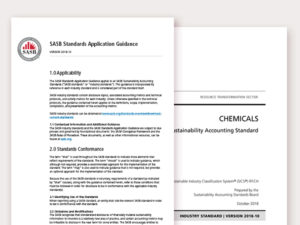Today, the SASB Standards Board published its first set of revised SASB Standards. The revisions focus on three industries: the Metals & Mining; Coal Operations; and Asset Management & Custody Activities industries. These revisions expand the disclosures topics included in two of the industries (Metals & Mining and Coal Operations) and narrow the disclosure topics included in the third (Asset Management & Custody Activities). While the changes are important for their substance, these changes are particularly notable because of what they represent. Some might frame it as change, others as evolution. I see it as stewardship.
When the SASB Standards were launched in late 2018, that event marketed the culmination of six years of work and extensive market engagement. The end result, while reflective of responding to market demands, wasn’t an artistic achievement analogous to publishing a novel or completing a commissioned work of art. Instead, a more apt analogy would be to property development or landscaping. Whether building a home or planting a garden, that work is never “done”, at least not to the point where the home or garden can be neglected indefinitely. Similarly, the launch of the SASB Standards in 2018 was as much the start of the SASB Standards Board’s work as it was a completion or culmination.
Since that time, the world has moved on. Awareness of sustainability issues have evolved, events have occurred (sometimes tragically so), and the use of SASB Standards in the marketplace has grown exponentially. All of this has created opportunities for the Standards Board to cultivate improvements to the SASB Standards. This is especially so because the SASB Standards are tailored to 77 industries. Not all sustainability issues matter equally to each industry, and the same sustainability issue can manifest differently across industries, hence the industry-specific approach. Maintaining 77 industry standards undoubtedly adds to the complexity of standard setting. One-size-fits-all approaches might be convenient to develop, but could come at the expense of poor fit. That said, the flipside of the complexity that comes with industry standards is that improvements can be addressed in a more targeted fashion. Let me offer an example.
Just over 100 days after the Standards Board voted to codify the SASB Standards, a tailings storage facility Brumadinho, Brazil collapsed killing more than 250 individuals and causing extensive environmental damage. In response to the disaster, investors came together to form the Investor Mining and Tailings Safety Initiative and directly asked extractives companies to be more transparent in their management of tailing facilities. The Brumadinho disaster also lead the International Council on Metals and Mining to partner with the United Nations Environment Program and the Principles for Responsible Investment to convene the Global Tailing Review, which developed the Global Industry Standard on Tailings Management, which is intended for tailings facilities operators.
With the increased calls from investors for improved transparency on tailings management and the industry efforts to raise the bar on tailings facility management, the Standards Board saw an opportunity to improve the coverage of this issue in the two industries where tailings facilities are commonly used and voted to initiate a related standard-setting project in December 2019. Throughout this standard setting project, technical staff followed and engaged with these investor and industry developments. Informed by this engagement and other outreach, the staff proposed expanding the coverage of tailings management in these two industry standards.
More specifically, an inventory of tailings storage facilities was already covered in the previous version of the standards under the Waste & Hazardous Materials Management disclosure topic. In the revised standards, tailings storage facilities management is its own disclosure topic, and it now addresses not only an expanded inventory of tailings storage facilities, but also systems and failure-prevention strategies as well as emergency preparedness and response plans.
Taking a step back from the details of these changes, I want to note that, if the SASB Standards had published as a series of essays, written in ink and then forgotten, or if they had written as very high level waste management or disaster preparedness guidance, agnostic of the rich context that can come by linking closely to business practices common in a given industry, then the tragedy in Brumadinho might have passed without implication for the Standards. Instead, it has resulted in revised – and we believe improved – Standards that better capture the connection between the impacts of company operations and the implications for enterprise value creation.
The revision to the Asset Management & Custody Activities Industry Standard offers another example of why standards needs cultivation and why the complexity of maintaining industry standards has benefits. Under the SASB SICS classification system, the Financials sector includes seven industries: Asset Management & Custody Activities, Commercial Banks, Consumer Finance, Insurance, Investment Banking, Mortgage Finance, and Security & Commodity Exchanges. While systemic risk is often associated with the Financial sector broadly, as a disclosure topic in the SASB Standards for the Financials sector, it only appears in the industry standard for Commercial Banks, Insurance, Investment Banking & Brokerage, and – prior to this revision – Asset Management & Custody Activities.
The disclosure topic in the Asset Management & Custody Activities standard addressed liquidity risk and interconnectivity of companies through lending and financing transactions. However, changes in prominent industry regulations and feedback from companies suggested that the topic was not likely to be particularly relevant to investors. In December of 2019, the Standards Board approved a standard-setting project that resulted in a proposal to remove the disclosure topic. While the type of adjustment for this standard is different than the adjustments made related to tailings, the circumstances were also different. And yet, by removing a poor-fitting systemic risk topic from the Asset Management & Custody Industry Standard, the resulting coverage of systemic risk in the Financials sector is a better overall fit.
In short, each of these changes is intended to not reflect change for change’s sake. Instead, they are meant to reflect the adaption necessary to reflect evolving sustainability issues across industries.

